Abstract
Membrane gas separation for carbon capture has traditionally been focused on high pressure applications, such as pre-combustion capture and natural gas sweetening. Recently a membrane-cryogenic combined process has been shown to be cost competitive for post-combustion capture from coal fired power stations. Here, the membrane-cryogenic combined process is investigated for application to post-combustion carbon capture from the flue gas of a Natural Gas Combined Cycle (NGCC) process. This process involves a three-membrane process, where the combustion air is used as the sweep gas on the second membrane stage to recycle CO2 through the turbine. This ensures high CO2 recovery and also increases the CO2 partial pressure in the flue gas. The three-CO2-selective membrane process with liquefaction and O2-enrichment was found to have a cost of capture higher than the corresponding process for coal post-combustion capture. This was attributed to the large size and energy duty of the gas handling equipment, especially the feed blower, because of the high gas throughput in the system caused by significant CO2 recycling. In addition, the economics were uncompetitive compared to a modelled solvent absorption processes for NGCC.
1. Introduction
Recent design developments in membrane gas separation are moving this technology towards being economically competitive for post-combustion carbon capture from coal-fired power stations [1,2]. Here these competitive membrane process designs are extended to post-combustion capture from a Natural Gas Combined Cycle (NGCC) process, to evaluate the viability of membrane technology.
Traditionally, membrane-based carbon capture has only been considered for natural gas sweetening before NGCC [3] and for pre-combustion capture before the IGCC process [4], while post-combustion capture has only been studied in depth using solvent absorption [5,6,7,8,9], or as a novel Integrated Gasification Combined Cycle (IGCC) process with flue gas recycling [10]. This is because for NGCC the flue gas has a low CO2 partial pressure which has previously been seen as a limitation for membrane gas separation. Belaissaoui et al. [11] recently proposed overcoming this for membrane systems through flue gas recycle, where some of the CO2 produced is recycled through the gas turbine resulting in a higher CO2 partial pressure. Similar flue gas recycle has been proposed for solvent absorption technology for NGCC [12]. For coal post-combustion, flue gas recycling has been shown by Merkel et al. [2] to make membrane separation viable for post-combustion capture from a coal-fired power station. In that case, the process consists of three CO2-selective membrane stages with a cryogenic liquefaction process for CO2 separation. Sweep gas on the second membrane stage is designed to recycle CO2 through the coal burner, and importantly enable the entire membrane process to operate at low pressure. This differs from Belaissaoui et al. process, which requires compression before the membrane stage. The three stages membrane process is able to recover over 90% of the CO2 and achieves a product purity of over 95% CO2 at a cost of capture comparable with current state-of-art solvent absorption technology. Hence, the three membrane stage combination presents itself as the current state of the art membrane process for post-combustion capture. As such, the three membrane stages design is applied here to post-combustion carbon capture from a NGCC process. This differs from Belaissaoui et al. design, in that the process presented here operates at low pressures.
The capture design utilises two CO2-selective membrane stages in series to concentrate CO2 in the permeate stream of the first membrane stage, and uses the second membrane stage to recycle CO2 back through the turbine (Figure 1). The CO2 rich permeate from the first membrane stage then undergoes water removal followed by compression and liquefaction to produce CO2 at the necessary purity. The membrane stages minimise the energy requirements of the liquefaction process by the exclusion of N2. The second membrane stage processes the retentate from the first membrane stage, and recycles CO2 back to the process feed stream through the turbine. This is possible because the combustion air for the turbine is used as a sweep gas on the second membrane stage. Combustion air as the sweep gas is a critical feature of the design to generate the pressure driving force across the membrane in order to maximise CO2 recovery while minimising membrane area and energy duty. However, recycling CO2 through the turbine (known as exhaust gas recirculation (EGR)) can result in limitations to the overall efficiency because of flame stability issues, incomplete oxidation of CO and changes to convection thermal transfer [13]. The third CO2-selective membrane stage recovers CO2 from the liquefaction column off-gas and recycles the permeate stream back to the first membrane stage permeate stream. The retentate from the third membrane stage is recycled back to the first membrane stage feed stream. This ensures all the CO2 around the liquefaction process is recovered while minimising the cooling duty.
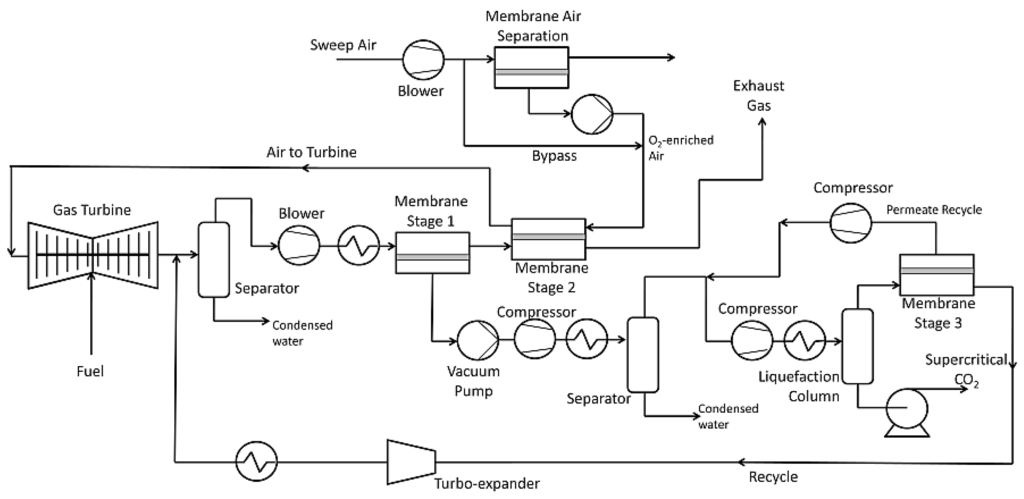
Figure 1.
Three CO2-membrane stages with liquefaction and O2-enrichment for post-combustion capture from a gas turbine.
The recycling of CO2 through the turbine also has the problem of reducing the O2 partial pressure in the combustion zone, and hence reduces the efficiency of the turbine because of incomplete combustion. Therefore, in this paper we have introduced a fourth O2-enrichment membrane stage on the combustion air upstream of the second membrane stage to counter the problem of reduced O2 partial pressure. This increases the O2 concentration of combustion air/sweep gas and ensures the correct O2 partial pressure is present in the gas turbine, as well as lowering N2 concentration to ensure the volumetric flowrate is similar to that of the non-EGR NGCC process. Substituting CO2 for N2 in the process will impact blade cooling, convection transfer and Heat Recovery Steam Generator (HRSG) operations [14]. However, the concept of O2 enrichment of the combustion air has previously been considered for oxy-fuel NGCC capture and is likely to be applicable in this configuration [10].
To enable comparison with other carbon capture technologies, economic analysis of the carbon capture options is also presented [15].
2. Methodology
2.1. Experimental
Aspen HYSYS software package (AspenTech, Bedford, MA, USA), version 7.5, was used for all simulations. The fluid package was Peng-Robinson, which is reliable over a wide range of temperatures and pressures, and has previously been applied to CO2 capture [16,17]. The gas separation membrane process was based on an in-house programmed module, using standard mass transfer equations for cross-flow and counter-flow configurations [18].
In the Aspen HYSYS simulations all units where operated with their default parameters, with pressure drop in piping negligible, while pumps, compressors and turbo-expanders operating at 75% efficiency. The membrane’s CO2 permeance was set at 1000 GPU, with a CO2/N2 selectivity of 50. This permeance and selectivity matches MTR’s Polaris membrane and is within the membrane performance range suggested for post-combustion capture by Merkel et al. [2] The O2 permeance was assumed equal to N2, while the H2O permeance was held constant at 10,000 GPU, consistent with literature [19]. A pressure drop of 10 kPa was assumed across both sides of the membrane stages. To ensure flow through the first and second membrane stages, the feed blower compressed the gas to 150 kPa. The first and third membrane stages were operated in a cross-flow configuration, while the second membrane stage with air sweep was operated in counter-current flow configuration. The O2-enrichment membrane was based on a cross-flow Air Products PRISM membrane process, with a blower on the feed to ensure flow through the membrane as well as the second membrane stage. A vacuum (22 kPa) on the air separation membrane permeate stream generates the pressure driving force. The O2-enrichment was to 50%, and the O2 partial pressure of the combustion air controlled through a bypass stream around the O2-enrichment membrane.
The permeate stream from the first CO2-selective membrane was compressed to 25 bar and cooled to 15 °C to remove the bulk of the water. The dry gas was then cooled to −20 °C and sent to a separator to recover liquefied CO2 at high purity. The off-gas from the separator was sent through a third CO2-selective membrane to ensure high CO2 recovery. Plasticization of the membrane at this pressure condition is possible, but not considered in these simulations as this third membrane stage has a minor role in the overall process ensuring recovery. Cooling duty was supplied by an ammonia based refrigeration cycle. All designs were set to capture over 90% of the CO2 from the flue gas and achieve at least 95% purity of CO2 in the product stream.
2.2. Economics
The capital expenditure (CAPEX) estimates for individual pieces of equipment were determined by Aspen’s Economic Evaluation package, 2010 1st Quarter, with default parameters. The cost of the CO2 selective membrane was taken from Merkel et al. [2] at US$50/m2, with a membrane installation factor of 1.6. The cost of the O2-enrichment membrane was US$20/m2, with a membrane installation factor of 1.6, the cost difference recognises this is mature technology. The CAPEX of the total process was the sum of the individual equipment costs, plus US$10 million for flue gas pretreatment. An additional loading of 25% was added to account for instrumentation, piping and electrical costs, plus an additional 13% for engineering and start-up costs. A final additional 10% was added as a project contingency to the CAPEX, in keeping with literature [20]. For operating expense (OPEX) estimates, the cost of electricity was $0.0576/kWh for NGCC which corresponds to a natural gas price of about US$5.81 per GJ [21]. Also included was a 5 year replacement period for all membranes and a 6% maintenance cost. To simplify the process simulations all membrane separation performance was assumed constant over this time period (i.e., no aging). The project life was 25 years, with 2 years construction period and 85% load factor. The real discount rate was 7%. The economics presented here do not take into account the transportation or injection of the CO2 product stream for geo-sequestration. Full details of the economic methodology can be found in Ho et al. [20].
The post-combustion flue gas conditions and composition are from a Natural Gas Combined Cycle power plant, based on a net output of 300 MW [5], provided in Table 1.

Table 1.
Flue gas conditions and composition from a Natural Gas Combined Cycle (NGCC) process, which is the basis of the process simulations.
3. Results and Discussion
The combination of two membrane stages with CO2 recycle through the turbine overcomes the limitation experienced with only one membrane stage; that is choosing between recovery or purity in the permeate stream. The two CO2-selective membrane stages in series on the flue gas feed enables both high CO2 recovery and high CO2 purity to be achieved in the permeate stream of the first membrane stage. This ensures that N2 is excluded from the liquefaction process and reduces the subsequent compression and cooling duty. In a NGCC power plant with capture, an important parameter in the design is the amount of CO2 being recycled through the turbine, via the combustion air sweep gas. This is varied by alternating the relative CO2 recovery in the first and second membrane stages, while always ensuring that the combined CO2 recovery is greater than 90%. The amount of CO2 being recycled through the turbine in this analysis is varied between 2.5% and 30%, with literature suggesting the impact from the higher recycle level, while significant, is within operational conditions of gas turbines [22]. Where a small recovery in the first membrane stage results in a significant amount of CO2 being recycled via the second membrane stage and vice versa. Importantly, the two stage membrane process ensures that the CO2 purity in the first stage permeate stream is always above 75%, irrespective of the individual membrane stage recoveries.
Altering the amount of CO2 being recycled through the process impacts the equipment size and energy duty. A large CO2 recycle reduces the membrane area for both the first and second membrane stages, because of the higher partial pressure. However, a large recycle rate also increases the energy duty of the process as the feed blower must handle increased throughput. This represents a trade-off between equipment cost through reduced membrane area and increased energy duty. The impact CO2 recycle has on cost of capture is shown in Figure 2. The NGCC process achieves a minimum in the cost of capture when the CO2 recycle going through the turbine is 0.25 mole fraction for NGCC. At lower CO2 recycle rates, the membrane area of the first and second stages are substantially large because the CO2 partial pressure is low, producing only a small driving force for separation. This resulted in a substantial CAPEX due to significant increases in membrane cost as well as OPEX increase because of higher membrane replacement cost. In contrast, at higher CO2 recycle of 0.3, there is a smaller membrane area, but the increase in energy demand of the feed blower, and a significant increase in OPEX offsets any reduction in membrane CAPEX. In terms of the gas turbine, operating the NGCC process with the combustion air having a CO2 mole fraction of 0.24 is theoretically possible. However, industrial testing will be required to demonstrate its feasibility.
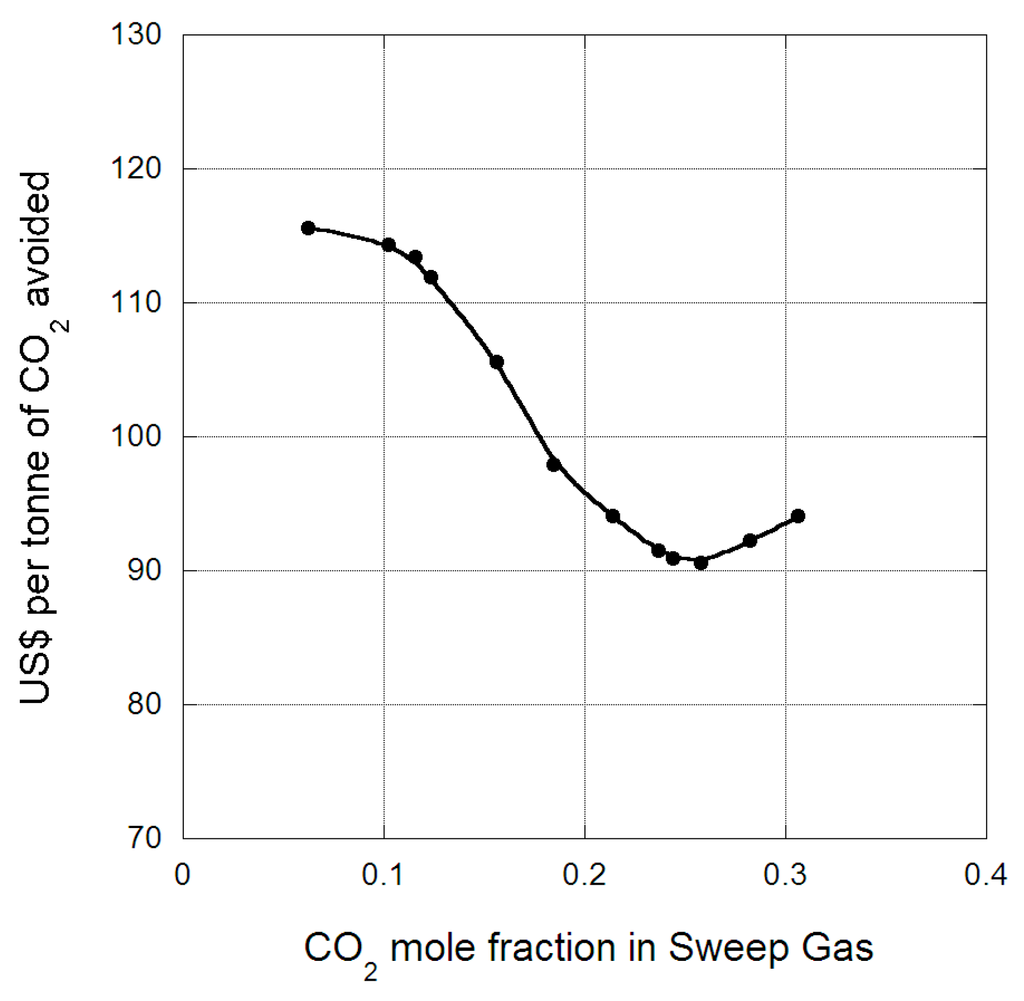
Figure 2.
Cost of capture (US$ per tonne of CO2 avoided) for NGCC as a function of recycle CO2 mole fraction.
For the NGCC scenario where the recycle rate is 0.24, the combined CO2-selective membrane area is 3.3 × 105 m2, which is comparable with existing natural gas sweetening membrane areas [3]. Of the CO2-selective membranes, the total area is mostly associated with the second membrane stage, given the high CO2 recycle through the turbine, while the third membrane stage area is less than 100 m2 to recycle the small amount of CO2 in the off-gas from the liquefaction process and the first membrane requires an area of about 1.6 × 104 m2. In comparison the O2-enrichment process membrane area is 7.9 × 105 m2. This area is more than double that of the CO2-selective membranes, and indicates the quantity of air for combustion needed to be processed to ensure the correct O2 partial pressure in the turbines.
As shown in Figure 2, the cost of post-combustion capture for a NGCC power plant with a combined three-CO2 selective membrane process and O2-enrichment membrane has a minimum capture cost of US$91 per tonne of CO2 avoided. This cost is greater than values reported for post-combustion NGCC capture using solvent technology. For a Fluor solvent the cost of capture is US$58 per tonne of CO2 avoided, and with a MHI solvent the cost of capture is US$48 per tonne of CO2 avoided [23]. The corresponding energy penalties for these processes are about 15% and 11% respectively. It should be noted that these costs are for a 776 MW NGCC process with the same operating lifetime and load factor, but a higher COE at $0.067/kWh. As such, the results suggest that the membrane process does not compete with solvent technology for NGCC. Furthermore, the cost for the proposed post-combustion NGCC membrane process has been shown to be lower if used at a supercritical coal-fired power station, with reported values of US$28–US$32 per tonne of CO2 avoided [24]. One of the main reasons for the difference in cost is the lower CO2 purity in the liquefaction process, 0.75 for the post-combustion NGCC compared to 0.9 CO2 mole fraction in the coal-fired power station process. This increases the energy duty for the vacuum pump, compressor and cooling. For the NGCC process the energy demand is 35% (117 MW). Hence, over a third of the power output from the power plant is consumed by the capture plant, whilst for the coal power plant it was less than 30%.
The breakdown of the energy duty for the capture plant is provided in Figure 3. The feed blower accounts for almost half of the energy duty of the capture plant. This unit operation is a blower, not a compressor, as it provides the necessary pressure (150 kPa) for the flue gas to pass through membrane stages 1 and 2. The significant energy duty is because of the large amount of CO2 recycle and considerable gas throughput in the process. The next major component, accounting for over a quarter of the energy demand is the vacuum pump on the first membrane stage to ensure sufficient partial pressure driving force across the membrane module. Hence, gas handling accounts for three quarters or more of the energy demand of this capture process, and highlights the major limitation of achieving significant energy savings for membrane processes with low CO2 partial pressure systems. The refrigeration cooling duty in the liquefaction process accounts for 19%.
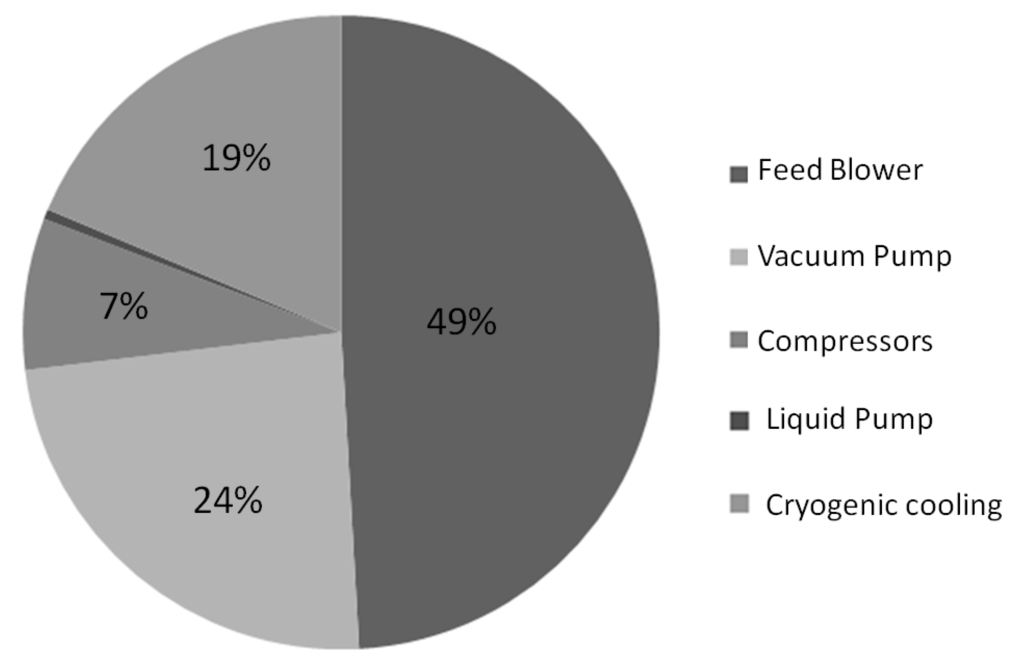
Figure 3.
Energy duty breakdown of the membrane-liquefaction process.
The CO2/N2 selectivity is a major membrane variable as it controls the purity of CO2 entering the liquefaction process. Improving the selectivity reduces both the compression and cooling duty of the process, because of exclusion of N2 from the liquefaction process. This represents a reduction in cost of capture, as shown in Figure 4 for the NGCC process. The cost of capture falls as selectivity increases and reaches a plateau at CO2/N2 = 150. Above this selectivity there is no savings made in the cost of capture because essentially enough of the N2 has been excluded from the permeate stream in the first membrane stage to meet the required CO2 concentration for storage, once water has been removed. At this selectivity, the cost of capture reduces to about US$83 per tonne of CO2 avoided, though it is still higher than conventional solvent technology. However, while a number of polymeric membrane materials have reported selectivities this high [25], to the authors’ knowledge none have been commercialized. One of the current best performing membrane for post-combustion capture is MTR’s Polaris, which has a CO2/N2 selectivity of 50 [2]. Hence, to obtain these potential decreases in cost of capture, further development of membrane materials and improvement in selectivity will be required.
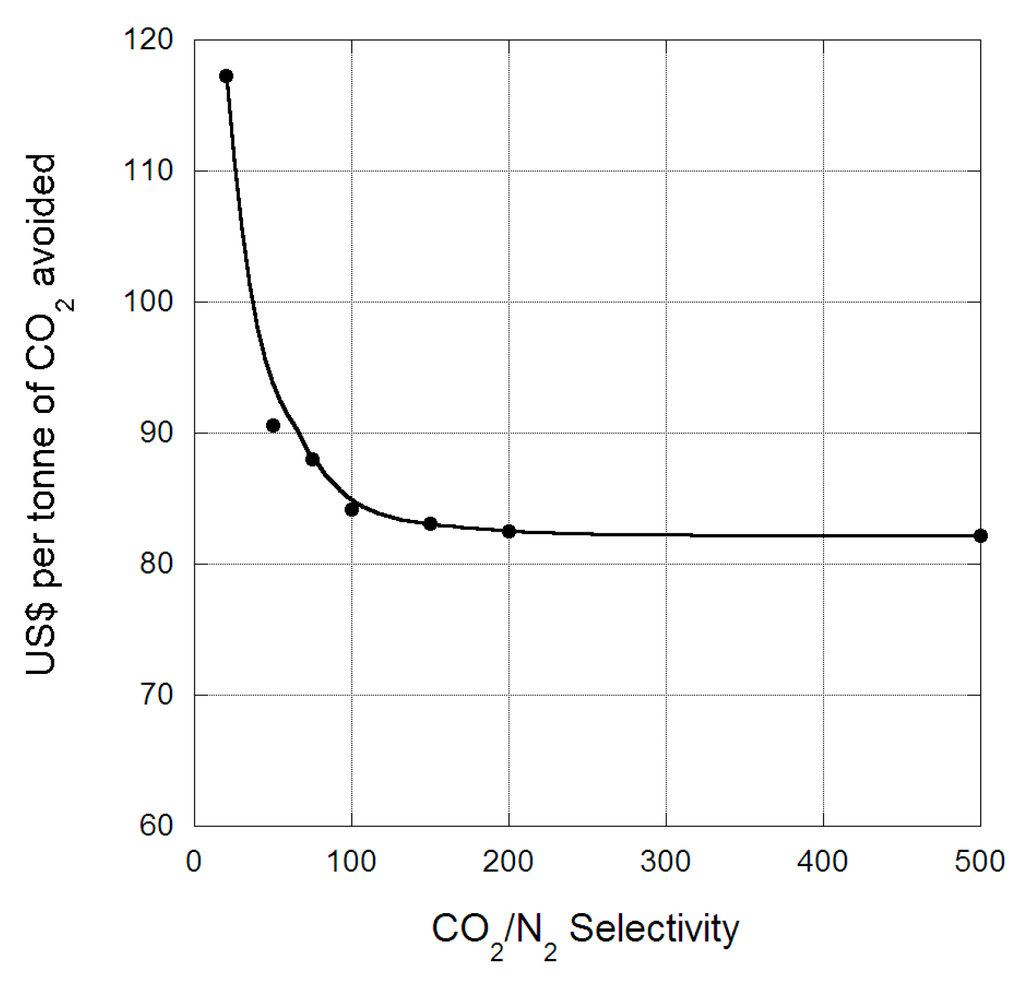
Figure 4.
Cost of capture (US$ per tonne of CO2 avoided) for NGCC as a function of membrane CO2/N2 selectivity.
The CAPEX breakdown of the capture plant is provided in Figure 5. The biggest capital expense is the blower/compressor/vacuum pump for gas handling. The next biggest expense is the general cost, of piping, instrumentation, etc. The CO2-selective membranes contribute 18% to the CAPEX. Hence, to achieve a CAPEX reduction, savings must be made to the gas handling equipment, in particular the feed blower which accounts for 26% of the CAPEX.
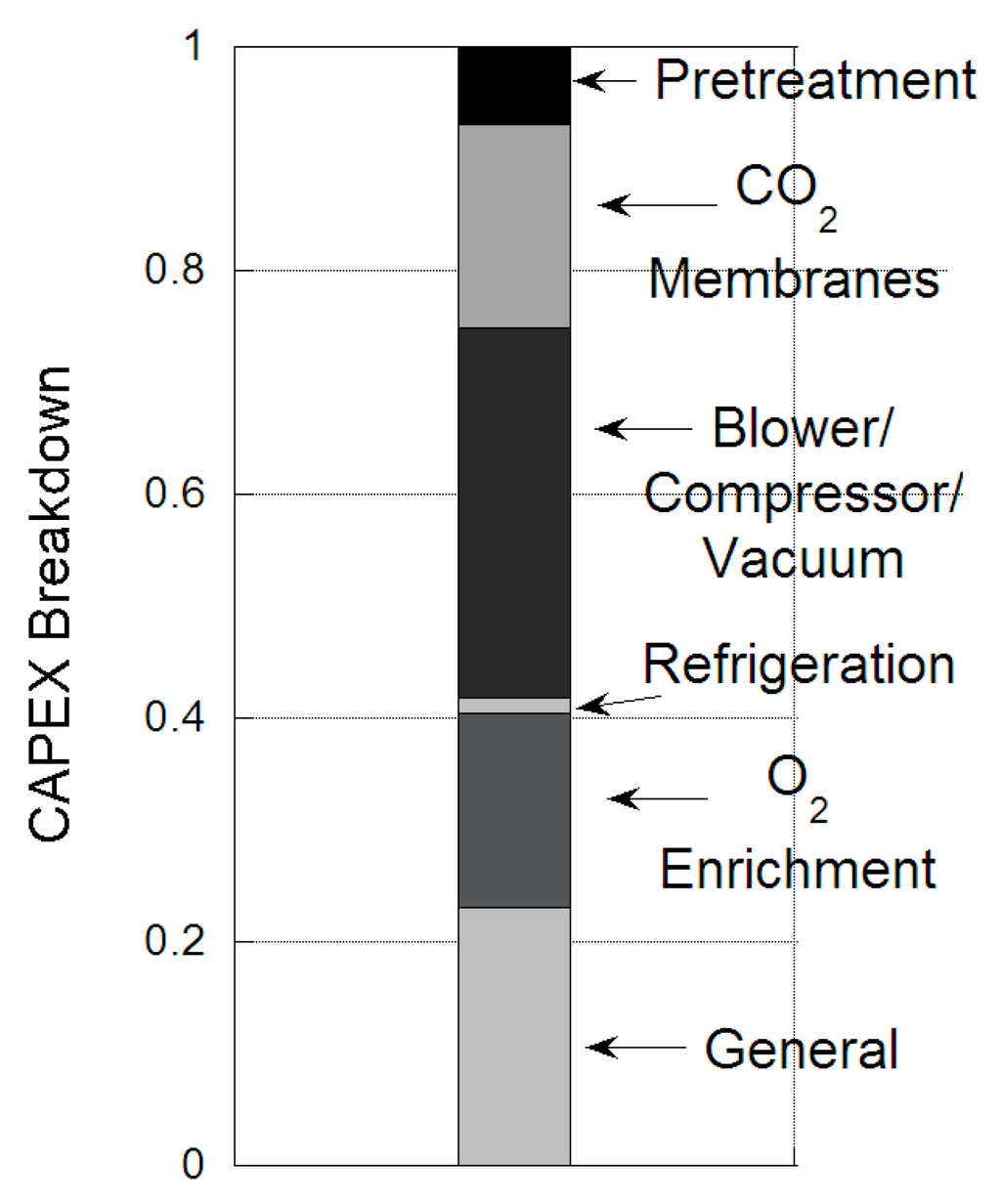
Figure 5.
CAPEX breakdown of NGCC post-combustion membrane capture plant.
The OPEX breakdown is provided in Figure 6. Again, the biggest contribution is the energy cost for gas handling, account for 50%. The next largest contributor to the OPEX is the general cost, including cooling water and plant maintenance. The refrigeration duty is 3% of the OPEX, O2 enrichment process is 7%, because of the high air throughput, while membrane replacement is less than 7%.
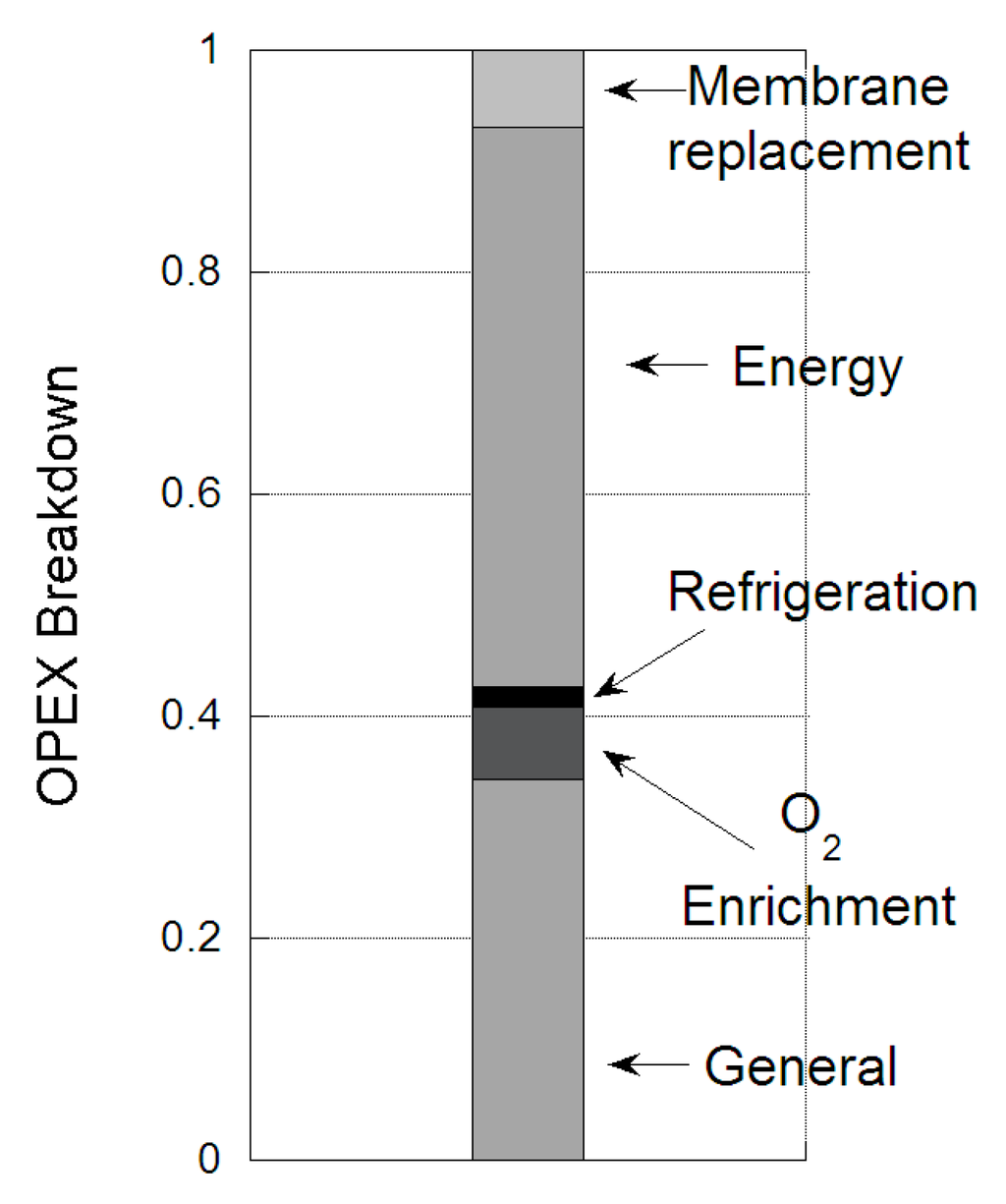
Figure 6.
OPEX breakdown of NGCC post-combustion membrane capture plant.
One option to reduce the cost of capture could be to eliminate the feed blower from the process, given that it accounts for almost half the energy duty of the process because of the high gas throughput. This will require the exhaust gas from the Heat Recovery Steam Generator (HRSG) to be at sufficient pressure to ensure flow through the associated duct work. However, reducing the HRSG back pressure results in a reduction to the power output and efficiency of the combined cycle, ~0.25% loss per 50 mbar [26]. Removing the blower and incorporating the power loss because of increased flue gas pressure, indicates that the energy demand for the membrane capture plant becomes 60 MW, and reduces the parasitic load on the NGCC plant to 20%. The cost of capture for the process without the feed blower is provided in Figure 7, as a function of membrane CO2/N2 selectivity. At a CO2/N2 selectivity of 50, the cost of capture for NGCC reduces to US$67 per tonne of CO2 avoided if the blower is excluded, which represents a saving of 26% compared to the baseline case. Again, the cost of capture reduces with increased selectivity until it reaches a constant value at CO2/N2 = 200, because of the high CO2 purity in the permeate stream eliminates the need for liquefaction.
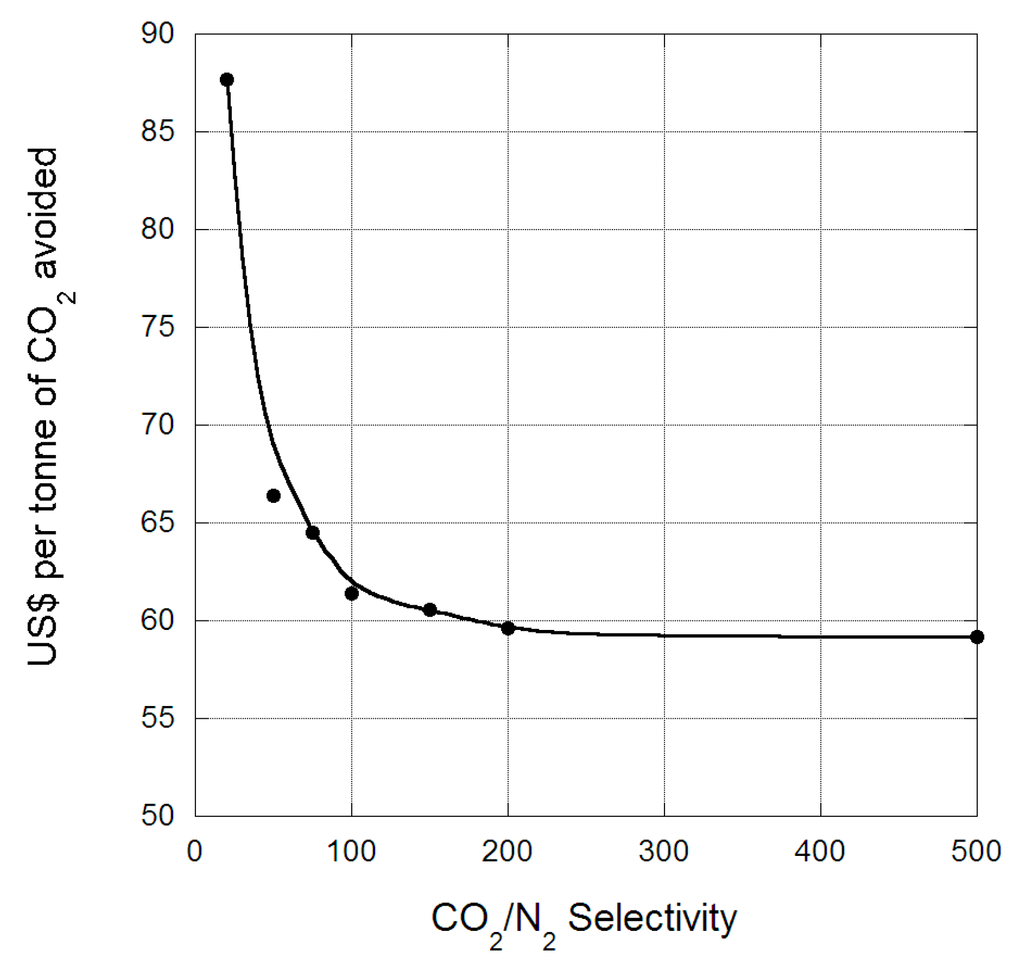
Figure 7.
Cost of capture (US$ per tonne of CO2 avoided) for NGCC as a function of membrane CO2/N2 selectivity, with no blower.
4. Conclusions
A three-CO2-selective membrane with liquefaction and O2-enrichment process was shown not to be competitive for post-combustion carbon capture compared to conventional chemical absorption technology when applied to the flue gas of NGCC. The process achieves a minimum in cost of capture when a significant amount of CO2 is recycled through the turbine in the combustion air. The feed blower accounts for almost half of the energy duty of the plant, due to the high gas throughput. This highlights the strong dependence the membrane-liquefaction process design has on CO2 partial pressure in the flue gas to be competitive with other CO2 separation technologies.
Acknowledgments
The authors would like to thank the Cooperative Research Centre for Greenhouse Gas Technologies (CO2CRC) for funding.
Author Contributions
Colin A. Scholes and Minh T. Ho conceived and designed the experiments; Colin A. Scholes performed the process simulations; Minh T. Ho undertook the economic analysis; Colin A. Scholes, Minh T. Ho and Dianne E. Wiley analyzed the data and wrote the paper. All authors have read and approved the final manuscript.
Conflicts of Interest
The authors declare no conflict of interest.
Reference
- Favre, E.; Bounaceur, R.; Roizard, D. A hybrid process combining oxygen enriched air combustion and membrane separation for post-combustion carbon dioxide capture. Sep. Purif. Technol. 2009, 68, 30–36. [Google Scholar] [CrossRef]
- Merkel, T.C.; Lin, H.; Wei, X.; Baker, R. Power plant post-combustion carbon dioxide capture: An opportunity for membranes. J. Membr. Sci. 2010, 359, 126–139. [Google Scholar] [CrossRef]
- Scholes, C.A.; Stevens, G.W.; Kentish, S.E. Membrane gas separation applications in natural gas processing. Fuel 2012, 96, 15–28. [Google Scholar] [CrossRef]
- Scholes, C.A.; Smith, K.H.; Kentish, S.E.; Stevens, G.W. CO2 capture from pre-combustion processes—Strategies for membrane gas separation. Int. J. Greenh. Gas Control 2010, 4, 739–755. [Google Scholar] [CrossRef]
- Amann, J.-M.G.; Bouallou, C. CO2 capture from power stations running with natural gas (NGCC) and pulverized coal (PC): Assessment of a new chemical solvent based on aqueous solutions of n-methyldiethanol amine + triehtylene tetramine. Energy Procedia 2009, 1, 909–916. [Google Scholar] [CrossRef]
- Falk-Pedersen, O.; Bjerve, Y.; Glittum, G.; Ronning, S. Separation of carbon dioxide from offshore gas turbine exhaust. Energy Convers. Manag. 1995, 6–9, 393–396. [Google Scholar] [CrossRef]
- Li, H.; Haugen, G.; Ditaranto, M.; Berstad, D.; Jordal, K. Impacts of exhaust gas recirculation (egr) on the natural gas combined cycle integrated with chemical absorption CO2 capture technology. Energy Procedia 2011, 4, 1411–1418. [Google Scholar] [CrossRef]
- Mofarahi, M.; Khojasteh, Y.; Khaledi, H.; Farahnak, A. Design of CO2 absorption plant for recovery of CO2 from flue gases of gas turbine. Energy 2008, 33, 1311–1319. [Google Scholar] [CrossRef]
- Peeters, A.N.M.; Faaij, A.P.C.; Turkenburg, W.C. Techno-economic analysis of natural gas combined cycles with post-combustion CO2 absorption, including a detailed evaluation of the development potential. Int. J. Greenh. Gas Control 2007, 1, 396–417. [Google Scholar] [CrossRef]
- Shao, Y.; Golomb, D. Power plants with CO2 capture using integrated air separation and flue gas recycling. Energy Convers. Manag. 1996, 37, 903–908. [Google Scholar] [CrossRef]
- Belaissaoui, B.; Cabot, G.; Cabot, M.-S.; Willson, D.; Favre, E. An energetic analysis of CO2 capture on a gas turbine combining flue gas recirculation and membrane separation. Energy 2012, 38, 167–175. [Google Scholar] [CrossRef]
- Shao, Y.; Golomb, D.; Brown, G. Natural gas fired combined cycle power plant with CO2 capture. Energy Convers. Manag. 1995, 36, 1115–1128. [Google Scholar] [CrossRef]
- Sipocz, N.; Tobiesen, A.; Assadi, M. Integrated modelling and simulation of a 400 MW NGCC power plant with CO2 capture. Energy Procedia 2011, 4, 1941–1948. [Google Scholar] [CrossRef]
- Bolland, O.; Mathieu, P. Comparison of two CO2 removal options in combined cycle power plants. Energy Convers. Manag. 1998, 39, 1653–1663. [Google Scholar] [CrossRef]
- Allinson, G.; Ho, M.T.; Neal, P.N.; Wiley, D.E. The methodology used for estimating the costs of CCS. In Proceedings of the 8th International Conference on Greenhouse Gas Technologies, Tronheim, Norway, 19–22 June 2006.
- Desideri, U.; Paolucci, A. Performance modelling of a carbon dioxide removal system for power plants. Energy Convers. Manag. 1999, 40, 1899–1915. [Google Scholar] [CrossRef]
- Scholes, C.A.; Anderson, C.J.; Cuthbertson, R.; Stevens, G.W.; Kentish, S.E. Simulations of membrane gas separation: Chemical solvent absorption hybrid plants simulations for pre- and post-combustion carbon capture. Sep. Sci. Technol. 2013, 48, 1954–1962. [Google Scholar] [CrossRef]
- Zolandz, R.R.; Fleming, G.K. Design of gas separation systems. In Membrane Handbook; Ho, W.S.W., Sirkar, K.K., Eds.; Kluwer Academic: Norwell, MA, USA, 1992; pp. 54–77. [Google Scholar]
- Scholes, C.A.; Kentish, S.E.; Stevens, G.W. Effects of minor components in carbon dioxide capture using polymeric gas separation membranes. Sep. Purif. Rev. 2009, 38, 1–44. [Google Scholar] [CrossRef]
- Ho, M.T.; Allinson, G.W.; Wiley, D.E. Reducing the cost of CO2 capture from flue gases using membrane technology. Ind. Eng. Chem. Res. 2008, 47, 1562–1568. [Google Scholar] [CrossRef]
- Fout, T.; Zoelle, A.; Keairns, D.; Turner, M.; Woods, M.; Kuehn, N.; Shah, V.; Chou, V.; Pinkerton, L. Cost and Performance Baseline for Fossil Energy Plants. Volume 1a: Bituminous Coal (pc) and Natural Gas to Electricity; National Energy Technology Laboratory, U.S. Department of Energy: Washington, DC, USA, 2015. [Google Scholar]
- Jonshagen, K.; Sipocz, N.; Genrup, M. Optimal combined cycle for CO2 capture with EGR. In Proceedings of the ASME Turbo Expo, Glasgow, UK, 14–18 June 2010.
- Davison, J. Performance and costs of power plants with capture and storage of CO2. Energy 2007, 32, 1163–1176. [Google Scholar] [CrossRef]
- Scholes, C.A.; Ho, M.T.; Stevens, G.W.; Kentish, S.E. Cost competitive membrane-Cryogenic post-combustion carbon capture. Int. J. Greenh. Gas Control 2013, 17, 341–348. [Google Scholar] [CrossRef]
- Powell, C.E.; Qiao, G.G. Polymeric CO2/N2 gas separation membranes for the capture of carbon dioxide from power plant flue gases. J. Membr. Sci. 2006, 279, 1–49. [Google Scholar] [CrossRef]
- Kehlhofer, R.; Rukes, B.; Hannemann, F.; Stirnimann, F. Combined-Cycle Gas & Steam Turbine Power Plants; PennWell: Tulsa, OK, USA, 2009. [Google Scholar]
© 2016 by the authors; licensee MDPI, Basel, Switzerland. This article is an open access article distributed under the terms and conditions of the Creative Commons Attribution (CC-BY) license (http://creativecommons.org/licenses/by/4.0/).